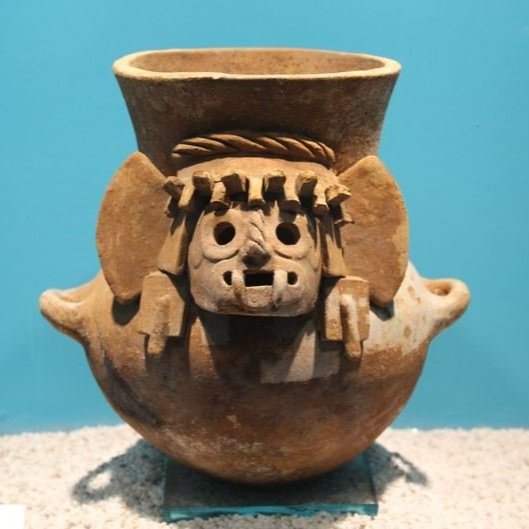The Best Places Around the World to See Aztec Art
The Aztec civilization of ancient Mexico produced a rich artistic tradition of monumental stone sculptures, vibrant pictorial codices, exquisite turquoise mosaics and decorative arts, and intricate ceramics and objects.
While the premier Aztec Art collections reside in Mexico City, there are several world-class museums around the globe that provide opportunities to experience the sophistication and artistry of Aztec visual culture.
Read on to find the best places to view Aztec art treasures.
Table of Contents
1. National Museum of Anthropology (Mexico City)
2. Templo Mayor Museum (Mexico City)
3. Zona Arqueológica de Teotihuacán (Mexico State)
4. Museo Regional de Cholula (Puebla)
1. National Museum of Anthropology (Mexico City)
The National Museum of Anthropology houses the most extensive and impressive collection of Aztec art and artifacts in the world.
Its Aztec exhibits are a true marvel, showcasing iconic masterpieces like the famous Aztec Calendar Stone and the intricate carvings of the Xochicalco reliefs.
A centerpiece is the awe-inspiring Coatlicue sculpture, a massive and intricately carved stone depiction of the fearsome Aztec earth goddess.
The museum's galleries are filled with exquisite stone sculptures depicting Aztec deities, rituals, and scenes from daily life, providing a vivid glimpse into this ancient civilization's beliefs and customs.
Visitors can also admire the gleaming beauty of Aztec gold artifacts and finely crafted ceramics that testify to the incredible artistry and skill of Aztec artisans.
With its unparalleled collection, the National Museum of Anthropology offers an unmatched opportunity to immerse oneself in the visual wonders of Aztec culture.
2. Templo Mayor Museum (Mexico City)
The Templo Mayor Museum is located next to the archaeological site of the main Aztec temple complex in Tenochtitlan.
Its exhibits feature an impressive array of artifacts excavated from the Templo Mayor, including intricate stone carvings, monumental sculptures like the Coyolxauhqui disk, and ritual objects.
There are eight main exhibition halls, each focused on different themes related to the Templo Mayor and Aztec culture, such as the goddesses Coatlicue and Coyolxauhqui, Ritual and sacrifice in Tenochtitlan, The god Tlaloc etc
Famous pieces on display are the Stone Cuauhxicalli Eagle and the Aztec Calendar Stone, providing insights into Aztec religious practices and iconography.
3. Zona Arqueológica de Teotihuacán (Mexico State)
While not of Aztec origin, the ancient city of Teotihuacan had a profound influence on Aztec art and architecture. The archaeological site contains impressive murals and intricate stone carvings that predate the Aztecs but were highly revered by them.
Visitors can see vibrant frescoes adorning the Palacio de los Jaguares and the famous Tepantitla compound, which features elaborate carved facades and sculptural reliefs that foreshadowed the grandeur of later Aztec artistic traditions.
Experiencing Teotihuacan provides valuable context for understanding the roots of Aztec visual culture.
4. Museo Regional de Cholula (Puebla)
The Museo Regional de Cholula offers visitors a glimpse into the rich cultural heritage of the Cholula region, including notable examples of Aztec art.
Among its collections are fine Aztec ceramics adorned with intricate designs and iconography, as well as carved stone sculptures depicting gods and important figures.
The museum also houses several Aztec codices, shedding light on this civilization's writing, pictorial traditions, and historical accounts. While more modest than national museums, Cholula's regional collection provides an opportunity to appreciate Aztec artistic achievements from this area.
5. Metropolitan Museum of Art (New York City)
The Metropolitan Museum of Art houses one of the finest collections of Aztec art and artifacts outside of Mexico.
The Met's galleries also showcase carved stone reliefs like the Batres Bas-Relief, providing vivid glimpses into Aztec ritual practices.
Visitors can study important pictorial codices such as the Codex Mendoza, illustrated manuscripts that document Aztec history, life, and traditions. Exquisite decorative arts are represented as well, including brilliantly colored featherworks, turquoise mosaics, and ornate ceremonial objects that attest to the Aztecs' incredible aesthetic sophistication.
6. British Museum (London)
The British Museum has an impressive collection of Aztec artifacts and objects on display in its Mexican Gallery. Here are some of the notable highlights:
Aztec Stone Sculptures
Life-size stone sculptures depicting Aztec deities and rulers, such as the famous Coatlicue statue (Mother of the Gods)
A carved stone coiled rattlesnake
A stone fire serpent sculpture representing lightning at the gallery's entrance
Turquoise Mosaics
The renowned turquoise mosaic mask of Quetzalcoatl (Feathered Serpent deity)
Other intricate turquoise mosaics showcasing Aztec craftsmanship
The British Museum's Mexican Gallery also features objects from other Mesoamerican cultures like the Maya and Mixtec, offering a comprehensive experience.
7. Museo de América (Madrid)
The collection managed by the preHispanic America department includes objects from different cultural areas and chronologies of the American continent. Among these are important ceramic groups from Andean or Mesoamerican cultures, which would include artifacts related to the Aztecs.
I hope you have found this blog post about where to see Aztec Art interesting and enjoyable. To find out more about other great artists, read here:
If you have any questions or comments, please email me at [email protected].









